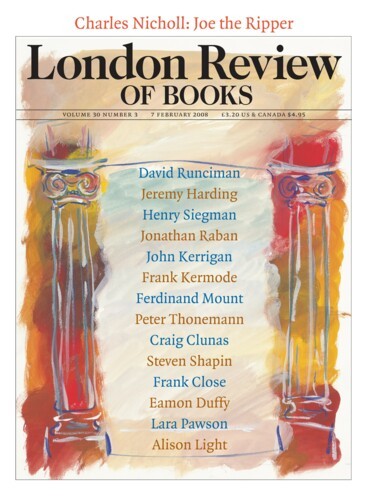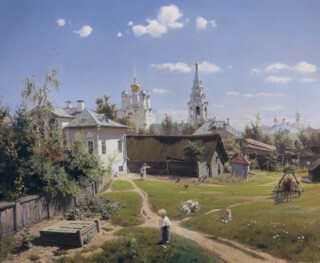The pictures, Russian and French in about equal numbers, lent for the exhibition From Russia – at the Royal Academy until 18 April – were made in the last quarter of the 19th century and the first quarter of the 20th. Early publicity for the show concentrated on the French paintings. This was not, I think, because we are familiar with the work of Cézanne, Matisse, Picasso and the Impressionists and not with the Russians. Kandinsky’s abstracts and Malevich’s black-on-white circle – it hangs like a full stop in the last room and seems to announce not just the end of the exhibition but the end of old painting – are as well known from histories of modern art as Matisse’s Dance and as much written about, if not, perhaps, as well loved. Nor, I think, is it just because the French pictures are better. The promotional advantage the French work had was, in part at least, the story that came with it.
Russian collectors – Sergei Ivanovich Shchukin and Ivan Abramovich Morozov in particular, but others too – felt the lift of a new wave at the turn of the century, and rode it. Unlike other collectors, they didn’t wait to surf its tail. The collections they made were nationalised after the Revolution (some former owners becoming guides, curators and ticket collectors). Later, the forced retirement of pictures to museum basements and, later still, their gradual, finally triumphant rehabilitation provided a coda to the stories of the collectors: humiliation was followed by posthumous vindication. The works themselves take on a double life as masterpieces and resurrected martyrs of modern art.
The quantities are amazing. Shchukin’s collection of 250 paintings, hung edge to edge in his ‘medium-sized mansion’, covered the walls from floor to ceiling. They included 13 by Monet, 16 by Gauguin, more than fifty by Picasso and dozens by Matisse. From Russia has five each from Cézanne, Matisse, Gauguin and Picasso: enough on their own for an exhibition. But, the hard-to-imagine power of the big Matisse apart, the French paintings only reinforce what you know. On the other hand, the juxtaposition of French and Russian pictures shows how distinctive Russian Modernism became in relation to new art from abroad and the traditions it broke with. Some Russians just learned to be like everyone else. In Serov’s portrait of Sophia Botkina (1899), the handling is freer than in the portrait of Nadezhda Polovtsova that Carolus-Duran was imported to paint twenty odd years earlier, but it is essentially an example of an international genre, the society portrait in haughty, brilliant, confident decline.
Turn to the landscapes and things are a little different. Daubigny’s Banks of the River Loing, painted in the late 1860s, is a crisp record of flat fields, very fresh and bright; in Levitan’s Summer Evening, painted thirty years later, a similar horizontal band of distant trees is more starkly lit. Evening is upon us. A shadow has advanced over the foreground. It is getting chillier. The Daubigny reads as a place, the Levitan as a mood. Landscape painting in Russia had become a vehicle for national pride and national self-examination. In an essay in the Royal Academy catalogue Yevgenia Petrova suggests that ‘sacralisation of art is something peculiar perhaps to the Russian mentality,’ and speculates that art of all sorts took the place of the pulpit and debating chamber when no channels for open discussion existed.* A retreat from high themes distressed the old guard and their audiences everywhere. In Russia – where art was deeply engaged with nationalist, religious and social themes – the loss was felt more strongly. So strongly indeed that you can watch mood and story stealthily creep back into the work of painters who have ostensibly taken their lead from French contemporaries.
Poppy Field (1890-91) and Haystack at Giverny (1888) by Monet, for example, are radically uninterested in anything other than the look of things and, above all, in the way paint can evoke effects of light by blurring form and tuning colour values, adjusting saturation and hue as you do on a television set. Of Igor Grabar’s September Snow of 1903, by contrast, less radical technically but aiming at a similar luminous Monet-like presence, the catalogue note, picking up a mood that is surely intended, says: ‘This is a truly poetic work conveying the beauty and “abandonedness” of a Moscow suburban estate.’
The contrast, clear enough in landscapes, is even more obvious when figures are involved. Matisse’s The Dance (1910) shows five dancers: three have their faces completely hidden; those of the other two are not much more than hieroglyphs. The force of the picture cannot be separated from its subject – women dancing – but a story in which these were individual characters is precluded. A theatre director might use masks to set an analogous distance between actors and the parts they play. Much that is accidental has been eliminated but the arrangement of the figures in space is complex, as though a Baroque engine were driving a Modernist machine. The left-facing figure at the top of the canvas leans forward; her head, back and torso are foreshortened. A version of the pose (indeed of all the poses) could probably be found in Rubens. Kuzma Petrov-Vodkin’s Boys Playing (1911) is so similar in its elements – naked figures, warmish in colour, holding hands against a green hill with a blue sky above – that it is hard to believe there is no connection with the Matisse. It is even signed and dated in similar script in the same corner. The effect, however, is utterly different. The blond boy’s girlish face, the black-haired boy’s face-covering gesture, the very un-Baroque flattening out of the figures onto a narrow stage parallel to the picture plane, the refusal to give up the pleasure of showing an expression or meaningful gestures are – in comparison – embarrassments. ‘The difference in characters and temperaments of the two subjects is revealed,’ the catalogue notes, ‘in the painterly expression of the bodies and the rhythm of the lines.’ Of Petrov-Vodkin’s Bathing the Red Horse (1912), it says that the painting ‘was received by contemporaries as a metaphoric expression for their time, as a kind of unique premonition of the events which the 20th century would soon bring’.
Once you become attuned to the need Russian painters, even radical ones, had for meanings and messages, differences from other Modernist streams become apparent. The most extreme case is Malevich, who thought that church and factory were essentially identical – ‘the goal,’ he said, ‘is the same, and the meaning lies in the search for God’ – and saw his Black Square as ‘a bare icon without a frame (like a pocket), an icon of my times’. Abstraction could not stifle the need for meaning, even though it might drive the search into unlikely country. It would be some time before Rothko and others began to talk so plainly about abstraction and the human spirit.
Borrowed styles and native ones could both lead back to the social and the spiritual. Ilya Repin’s October 17, 1905 (1907), a broad-based pyramid of figures, one waving a chain and manacles (they are cheering Nicholas II’s proclamation of reforms), is the one picture in the exhibition that connects clearly with what may be the most famous of all Russian pictures: Repin’s own Barge Haulers on the Volga of 1870-73, reproduced in the catalogue but perhaps not allowed to leave Russia. The belief some Russian artists had in the possibility of a Modernism that was popular – an escape from bourgeois convention and a continuation in a better world of the aspirations embedded in paintings like Repin’s – was very imperfectly realised. Styles have lives of their own. Echoes of Rodchenko and Tatlin can be found today in new buildings and smart magazines. This may be Russian Modernism’s truest, if not its most welcome legacy.
Send Letters To:
The Editor
London Review of Books,
28 Little Russell Street
London, WC1A 2HN
letters@lrb.co.uk
Please include name, address, and a telephone number.


